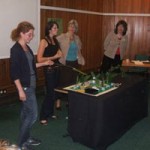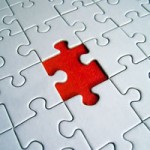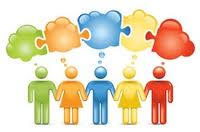I came across this article in a wonderful site full of resources and articles called Mind Tools
Identifying Both Positive and Negative Group Behaviour Roles
 A team is made up of all sorts of people. How these people interact and relate to one another is a key factor in determining how successful the team will be at achieving its mission. So, how do people behave in the teams that you work with?
A team is made up of all sorts of people. How these people interact and relate to one another is a key factor in determining how successful the team will be at achieving its mission. So, how do people behave in the teams that you work with?
The way that people behave in teams varies. Some people are helpful and supportive, others are more concerned with getting the work done, and still others can cause friction, disharmony or discord within the team.
You’ve probably worked in some teams that are effective and some that aren’t. While there is no magic elixir, knowing what moves teams forward and what limits their progress can be helpful whenever you are working in a group or team.
Two influential theorists on group behavior were Kenneth Benne and Paul Sheats, who wrote a respected article titled “Functional Roles of Group Members” back in the 1940s. In it, they defined 26 different group roles that can be played by one or more people within a group. Their work influenced other early research and thinking on group functions. And whilst more recent research has refined many of these ideas, Benne and Sheats’ Group Roles remains a useful and interesting way of looking at group behavior.
Benne and Sheats defined three categories of group roles: task roles, personal and social roles, and dysfunctional or individualistic roles.
Task Roles
 These are the roles that relate to getting the work done. They represent the different roles needed to take a project step-by-step from initial conception through to action. (Individuals may fulfill many of these roles during the life of a project.)
These are the roles that relate to getting the work done. They represent the different roles needed to take a project step-by-step from initial conception through to action. (Individuals may fulfill many of these roles during the life of a project.)
Initiator/Contributor – Proposes original ideas or different ways of approaching group problems or goals. This role initiates discussions and move groups into new areas of exploration.
Information Seeker – Requests clarification of comments in terms of their factual adequacy. Seeks expert information or facts relevant to the problem. Determines what information is missing and needs to be found before moving forward.
Information Giver – Provides factual information to the group. Is seen as an authority on the subject and relates own experience when relevant.
Opinion Seeker – Asks for clarification of the values, attitudes, and opinions of group members. Checks to make sure different perspectives are given.
Opinion Giver – Expresses his or her own opinions and beliefs about the subject being discussed. Often states opinions in terms of what the group “should” do.
Elaborator – Takes other people’s initial ideas and builds on them with examples, relevant facts and data. Also looks at the consequences of proposed ideas and actions.
Co-ordinator – Identifies and explains the relationships between ideas. May pull together a few different ideas and make them cohesive.
Orienter – Reviews and clarifies the group’s position. Provides a summary of what has been accomplished, notes where the group has veered off course, and suggests how to get back on target.
Evaluator/Critic – Evaluates proposals against a predetermined or objective standard. Assesses the reasonableness of a proposal and looks at whether it is fact-based and manageable as a solution.
Energizer – Concentrates the group’s energy on forward movement. Challenges and stimulates the group to take further action.
Procedural Technician – Facilitates group discussion by taking care of logistical concerns like where meetings are to take place and what supplies are needed for each meeting.
Recorder – Acts as the secretary or minute-keeper. Records ideas and keeps track of what goes on at each meeting.
Personal and/or Social Roles
These roles contribute to the positive functioning of the group.
 Encourager – Affirms, supports, and praises the efforts of fellow group members. Demonstrates warmth and provides a positive attitude in meetings.
Encourager – Affirms, supports, and praises the efforts of fellow group members. Demonstrates warmth and provides a positive attitude in meetings.
Harmonizer – Conciliates differences between individuals. Seeks ways to reduce tension and diffuse a situation by providing further explanations or using humor.
Compromiser – Offers to change his or her position for the good of the group. Willing to yield position or meet others half way.
Gatekeeper/Expediter – Regulates the flow of communication. Makes sure all members have a chance to express themselves by encouraging the shy and quiet members to contribute their ideas. Limits those who dominate the conversation and may suggest group rules or standards that ensure everyone gets a chance to speak up.
Observer/Commentator – Provides feedback to the group about how it is functioning. Often seen when a group wants to set, evaluate, or change its standards and processes.
Follower – Accepts what others say and decide even though he or she has not contributed to the decision or expressed own thoughts. Seen as a listener not a contributor.
Dysfunctional and/or Individualistic Roles
These roles disrupt group progress and weaken its cohesion.
 Aggressor – Makes personal attacks using belittling and insulting comments, for example, “That’s the most ridiculous idea I’ve ever heard.” Actions are usually an attempt to decrease another member’s status.
Aggressor – Makes personal attacks using belittling and insulting comments, for example, “That’s the most ridiculous idea I’ve ever heard.” Actions are usually an attempt to decrease another member’s status.
Blocker – Opposes every idea or opinion that is put forward and yet refuses to make own suggestions, for example, “That’s not a good idea.” The result is that the group stalls because it can’t get past the resistance.
Recognition Seeker – Uses group meetings to draw personal attention to him or herself. May brag about past accomplishments or relay irrelevant stories that paint him or her in a positive light. Sometimes pulls crazy stunts to attract attention like acting silly, making excess noise, or otherwise directing members away from the task at hand.
Self-Confessor – Uses the group meetings as an avenue to disclose personal feelings and issues. Tries to slip these comments in under the guise of relevance, such as “That reminds me of a time when.” May relate group actions to his or her personal life. For example, if two others are disagreeing about something, the Self-confessor may say, “You guys fight just like me and my wife.”
Disrupter/Playboy or Playgirl – Uses group meetings as fun time and a way to get out of real work. Distracts other people by telling jokes, playing pranks, or even reading unrelated material.
Dominator – Tries to control the conversation and dictate what people should be doing. Often exaggerates his or her knowledge and will monopolize any conversation claiming to know more about the situation and have better solutions than anybody else.
Help Seeker – Actively looks for sympathy by expressing feelings of inadequacy. Acts helpless, self deprecating and unable to contribute. For example, “I can’t help you, I’m too confused and useless with this stuff.”
Special Interest Pleader – Makes suggestions based on what others would think or feel. Avoids revealing his or her own biases or opinions by using a stereotypical position instead, for example, “The people over in Admin sure wouldn’t like that idea.” or “You know how cheap our suppliers are, they won’t go for that.”
Using Benne and Sheats’ Theory
 Benne and Sheats’ work did not actually prescribe any application of their theory; they simply identified the roles. However, we can use the theory to look at and improve group effectiveness and harmony, by asking what roles are being filled, which additional ones might be required, and which may need to be eliminated.
Benne and Sheats’ work did not actually prescribe any application of their theory; they simply identified the roles. However, we can use the theory to look at and improve group effectiveness and harmony, by asking what roles are being filled, which additional ones might be required, and which may need to be eliminated.
Benne and Sheats noted that the roles required in a group can vary depending on the stage of group development and the tasks in hand. And it’s useful to consider how your group is developing and how the task may vary when reviewing your group’s roles.
Follow these steps to use Benne and Sheats’ theory to consider the roles in your group:
Step 1: Determine What Stage or Function Your Group is at, Based on What You’re Working on or Discussing
Here are some common group stages/functions:
- Forming.
- Discussing tasks and roles.
- Setting out expectations.
- Goal setting.
- Brainstorming ideas.
- Discussing alternatives.
- Completing tasks and duties.
- Making a decision.
- Implementing the solution.
- Evaluating performance.
Step 2: Determine Which Roles are Most Suitable and Helpful for the Current Stage/Function
Here are some examples:
- When first forming your group, you will not necessarily need anyone in the Evaluator/Critic or Orienter roles. You will, however, need Energizers, Procedural Technicians, and a Reporter.
- When discussing alternatives, it is important to have representation in as many Social/Personal roles as possible. Benne and Sheats suggested that the more group members playing Task and Social roles, the more successful the group would be.
Step 3: Recruit and/or Develop the Missing Roles Within Your Group
Help the group understand where there are gaps in the functions being represented and discuss how filling these roles would help the group’s success.
Benne and Sheats also said that the more flexible the group members are, the better; meaning that group members should be able to adapt their roles depending on the group’s need. With a flexible group structure like this, members each use a wide range of talents, and provide maximum contribution to the team.
Step 4: Identify any Dysfunctional Roles Being Played Within the Group
Make a plan to eliminate this behavior either through increased awareness, coaching, or feedback. These self-serving roles really must be minimised or eliminated for effective group work to emerge.
By making the whole group aware of these maladaptive behaviors, individuals can monitor the behavior and put a name to it when it occurs. This alone should decrease much of the disruptive behavior.
Tip:
This is an important and particularly useful part of this theory: These behaviours are disruptive and damaging. By spotting these behaviors and coaching people out of them, you can significantly improve your group process.
Step 5: Re-Evaluate Regularly
Groups are constantly changing their function and purpose. Make sure you continuously evaluate what is going on within the group and take action to maximize effectiveness.
Tip:
Benne and Sheats’ work is based on their observations, but there is no clear evidence to support the notion that you need to have all of these roles represented or to suggest what combination is the most effective. As such, don’t depend too heavily on this theory when structuring your team.
That said, just knowing about Benne and Sheats’ Team Roles can bring more harmony to your team, as it helps members appreciate the breadth of roles that can contribute to the work of a team and its social harmony, as well as the behaviors which will obstruct it’s path.
Key Points
There are many different explanations of group roles and functions. Each takes a slightly different perspective. However, the consensus seems to be that an effective group has a wide representation of positive roles. Groups need to be able to adapt to the changes from outside and within the group itself. People change, opinions change, conflicts occur; all of these require group flexibility and social understanding.
Benne and Sheats’ role definitions are useful for looking at specific behaviors that occur within a group. By using the definitions given and evaluating the current function and needs of the group, you can plan to encourage the sorts of behaviors you need and discourage those that you don’t. These definitions also provide a guide for team member development, as the more positive behaviors each person can display, the better able the whole group will be to respond to the demands put on it.